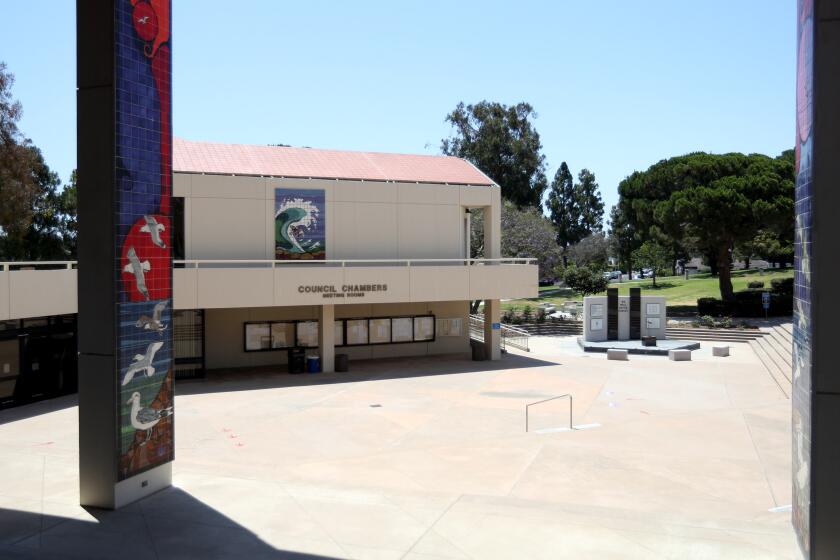FOCUS ON HEALTH:
- Share via
Sometimes I forget to breathe.
Not the everyday, keep-you-alive kind of breathing we all take for granted. No; I neglect to take those deep, relaxing, blow-up-your-diaphragm breaths that supposedly rejuvenate body and soul.
I know where my diaphragm is, but try as she might, Elizabeth, my editor and friend, has not been able to get me to breathe properly to inflate it.
Sure my life is hectic, like yours, and there are days when I forget to eat. But when the people closest to me began telling me to slow down, focus and take a damn breath, I figured it was time to get some outside help.
I’d seen the monthly Zen meditation classes offered at the Zen Center in Costa Mesa. After all, as calendar editor, it was my responsibility to put them there. I decided that’s where I’d go to learn how to de-stress.
The Zen Center looks like an old Victorian house. The class was held in a room on the top floor, with French doors leading to an outside deck.
The space was sunny and open, and although I was freezing the entire time, it was a very pleasant and inviting place to be.
This was an introductory zazen class — “za” means seated and “Zen” means meditation. You sit on a mat with a cushion, called a zafu, to be sure your posture is straight.
There are different positions in zazen: kneeling, chair sitting and the half-lotus, which is done with some version of crossed legs on the mat. I went for the half-lotus: one foot in front, the other crossed over it.
The three basic elements of zazen are posture, breathing and attention, in that order. Finally, I was about to learn to breathe! Not as a means in itself, but as a way to control my thought patterns.
In a society where we never stop moving, zazen can help us cope. We’re overwhelmed by technology, constantly responding to e-mail and voice-mail messages. Our teacher, Carol Aguilar, described all the noise we live with as a “radio frequency running us.”
Meditation teaches us how to turn off the radio and experience the world around us, using all of our senses to participate in the moment.
Carol walked us through a guided meditation for the first 15 minutes, talking to us, checking our posture and instructing us on how to “follow the breath” from inhalation to exhalation, counting each one if we felt ourselves getting distracted by outside stimuli.
I’m kind of old, so one hip hurt, but if I kept counting those breaths I managed to focus on meditating as opposed to praying I wouldn’t need a hip replacement.
We spent another 15 minutes in quiet meditation, then took a break before moving on to an awareness exercise. We drank an unspecified liquid from a small cup — smelling, tasting, touching and simply noticing what we were doing.
During meditation, the goal is not to solve our problems, or get bogged down in thinking about them to the point of obsession.
By becoming aware of our thoughts, we can release them, and deal with the issues at hand at a later, more appropriate time.
In case you’re wondering, I learned the liquid was apricot-papaya juice, which I guessed — well, the apricot part anyway — because of the velvety, sweet but tart taste I made sure I noticed as I drank.
The second half of the class focused on how to incorporate what we learned into our daily lives.
Carol encouraged us to find a place in our home where we could spend 15 minutes or so several times a week in quiet meditation.
“We don’t want to be conditioned beings,” she said. “We want to be awake and free beings.”
For a month following an introductory class like the one I took, the Zen Center also offers reading and instruction sessions to participants at no cost.
I feel calmer, more grateful and a lot more aware of the people and scenery around me since taking the class.
Now I do abbreviated meditation exercises, during which I stop for a minute and appreciate where I am and how it feels.
Oh, and I breathe.
The Zen Center is at 120 E. 18th St. in Costa Mesa. For information, call (949) 722-7818 or go to www.zcoc.org.
SUE THOENSEN may be reached at (714) 966-4627 or at sue.thoensen@latimes.com.
All the latest on Orange County from Orange County.
Get our free TimesOC newsletter.
You may occasionally receive promotional content from the Daily Pilot.







